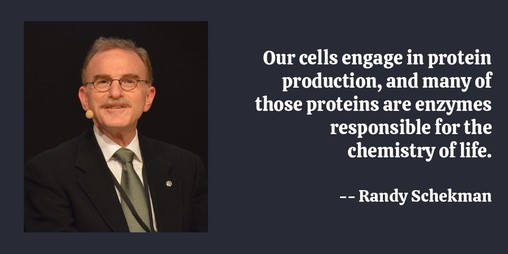Biochemistry
Our cells engage in protein production, and many of those proteins are enzymes responsible for the chemistry of life.
— Randy Schekman

Fundamental techniques
-
Protein quantification
- SDS-PAGE(In-gel)
- Western blot
- ELISA
-
Protein purification
- Purifying Challenging Proteins, Principles and Methods [PDF]
-
Protein interaction
- co-IP
- Proximity labeling
-
Protein identification
- Protein sequencing:
- IP-MS:
-
Organelle isolation
- mitochondria: Mito-IP []
- Lysosome: LysoIP []
- ER:
- Golgi: Golgi-IP []
- Synaptosome:
-
Cell culture basis
Vendor companies
- Cell Signaling Technology
- Abcam
- ThermoFisher
- R&D Systems
- BioRad
- ATCC: ATCC has the world’s largest and most extensive product catalog of human and animal cell lines for research purposes.
- Gibco
- Corning
- HyClone
- Sigma
Ref. Labs
Signaling pathways
- Discovery of cGAS-cGAMP pathway and its role in immune defense
- Sun, Lijun, et al. “Cyclic GMP-AMP synthase is a cytosolic DNA sensor that activates the type I interferon pathway.” Science 339.6121 (2013): 786-791. [PDF | PMID: 23258413 | DOI Link]
- Wu, Jiaxi, et al. “Cyclic GMP-AMP is an endogenous second messenger in innate immune signaling by cytosolic DNA.” Science 339.6121 (2013): 826-830. [PDF | DOI Link]
- The discovery of mTOR
- Sabatini et al. “RAFT1: a mammalian protein that binds to FKBP12 in a rapamycin-dependent fashion and is homologous to yeast TORs.” Cell 78.1 (1994): 35-43. [PDF | DOI Link]
- iBiology Talk [PartI: Introduction to mTOR and the regulation of growth]
- Systematic characterization of basic mechanisms that regulate growth including nutrient sensing pathways [CASTOR | Sestrin2 | SAMTOR]
- The discovery of mitochondria CytoC mediated apoptosis pathway
- Zou, Hua, et al. “Apaf-1, a human protein homologous to C. elegans CED-4, participates in cytochrome c–dependent activation of caspase-3.” Cell 90.3 (1997): 405-413. [PDF | PMID: 9267021 | DOI Link]
- Ronald David Vale Lab, University of California, San Francisco/HHMI
- The discovery of Kinesin [iBiology Talk]
- Vale, Ronald D., et al. “Direct observation of single kinesin molecules moving along microtubules.” Nature 380.6573 (1996): 451-453. [PDF | PMID: 8602245 | DOI Link]
- The Characterization of Molecular Motor Proteins [iBiology Talk 1 | iBiology Talk 2 | iBiology Talk 3]
- Sablin, Elena P., et al. “Crystal structure of the motor domain of the kinesin-related motor ncd.” Nature 380.6574 (1996): 555-559. [PDF | PMID: 8606780 | DOI Link]
-
The first to show that RNAi could be the basis for therapy in an animal model
-
Identification of novel mechanisms of mitochondrial and DNA damage activated by granzyme A
- The discovery and characterization of GSDMD mediated pyroptosis pathway [Online Talk]
Transcriptional regulation and epigenetics
- The discovery of the SV40 large T antigen
- Tjian, Robert. “The binding site on SV40 DNA for a T antigen-related protein.” Cell 13.1 (1978): 165-179. [PMID: 202398 | DOI Link]
- The discovery of first histone demethylase, LSD1
- The discovery of first RNA demethylase that oxidatively reverses N6-methyladenosine (m6A) methylation in mammalian messenger RNA
Structural Biology
- Structural basis of pre-mRNA splicing
- Structural basis of Apoptosis (Programmed Cell Death)
- Alzheimer’s Disease (AD) and Regulated Intramembrane Proteolysis (RIP)
- The discoverer of signalosomes, which are large macromolecular complexes involved in cell death and in innate and adaptive immune pathways.
- Structural basis of Membrane transport
- Structural and mechanistic investigation of sterol homeostasis
Ref. softwares
- PyMOL: PyMOL is a user-sponsored molecular visualization system on an open-source foundation, maintained and distributed by Schrödinger.
- UCSF ChimeraX: UCSF ChimeraX (or simply ChimeraX) is the next-generation molecular visualization program from the Resource for Biocomputing, Visualization, and Informatics (RBVI), following UCSF Chimera.
- HMMER: HMMER is a software package that provides tools for making
probabilistic models of protein and DNA sequence domain families –
called profile hidden Markov models, profile HMMs, or just profiles
– and for using these profiles to annotate new sequences, to search
sequence databases for additional homologs, and to make deep multiple sequence alignments.
- HMMER underlies several comprehensive collections of alignments and profiles of known protein and DNA sequence domain families, including the Pfam database. [User’s Guide]
- Pfam 35.0
- The Pfam database is a large collection of protein families, each represented by multiple sequence alignments and hidden Markov models (HMMs).
- Pfam 35.0 contains a total of 19,632 families and clans.
Tool development
-
PROXIMITY LABELING
- APEX
- TurbID
-
Stanford Neuro-omics Initiative, 2020 Virtual Workshop
Ref. Protocols
Nobel laureates
-
Carolyn Bertozzi, Stanford University, Stanford, CA, USA; Howard Hughes Medical Institute, USA [lab link]
The Nobel Prize in Chemistry 2022
The Bioorthogonal Chemistry Journey, from Laboratory to Life [Nobel Lecture video | Lecture Slides | Read the Lecture | Source]- iBiology Talk[PartII: Imaging the glycome]
-
Sir Peter J. Ratcliffe, University of Oxford, Oxford, United Kingdom; Francis Crick Institute, London, United Kingdom The Nobel Prize in Physiology or Medicine 2019
Elucidation of Oxygen Sensing Mechanisms in Human and Animal Cells [Nobel Lecture video | Lecture Slides | Read the Lecture | Source] -
William G. Kaelin Jr, Harvard Medical School, Boston, MA, USA; Howard Hughes Medical Institute, Chevy Chase, MD, USA; Dana-Farber Cancer Institute, Boston, MA, USA; Brigham and Women’s Hospital, Boston, MA, USA The Nobel Prize in Physiology or Medicine 2019
The von Hippel-Lindau Tumor Suppressor Gene: Insights into Oxygen Sensing and Cancer [Nobel Lecture video | Lecture Slides | Read the Lecture | Source] -
Gregg L. Semenza, Johns Hopkins University, Baltimore, MD, USA The Nobel Prize in Physiology or Medicine 2019
Hypoxia-Inducible Factors in Physiology and Medicine [Nobel Lecture video | Lecture Slides | Read the Lecture | Source] -
Yoshinori Ohsumi, Tokyo Institute of Technology, Tokyo, Japan
The Nobel Prize in Physiology or Medicine 2016
Molecular Mechanisms of Autophagy in Yeast [Nobel Lecture video | Lecture Slides | Read the Lecture | Source] -
Randy Schekman, University of California, Berkeley
The Nobel Prize in Physiology or Medicine 2013
Genes and Proteins That Control the Secretory Pathway [Nobel Lecture video | Lecture Slides | Read the Lecture | Source] -
Thomas C. Südhof, Stanford University
The Nobel Prize in Physiology or Medicine 2013
The Molecular Machine of Neurotransmitter Release [Nobel Lecture video | Lecture Slides | Read the Lecture | Source] -
Thomas A. Steitz, Yale University, New Haven, CT, USA/HHMI
The Nobel Prize in Chemistry 2009
From the Structure and Function of the Ribosome to New Antibiotics [[Nobel Lecture video | Lecture Slides | Read the Lecture | Source] -
Roger D. Kornberg(1947-), Stanford University, Stanford, CA, USA
The Nobel Prize in Chemistry 2006
The Molecular Basis of Eukaryotic Transcription [[Nobel Lecture video | Lecture Slides | Read the Lecture | Source] -
Aaron Ciechanover(1947-), Technion - Israel Institute of Technology, Haifa, Israel
The Nobel Prize in Chemistry 2004
Intracellular Protein Degradation: From a Vague Idea thru the Lysosome and the Ubiquitin-Proteasome System and onto Human Diseases and Drug Targeting [[Nobel Lecture video | Lecture Slides | Read the Lecture | Source] -
Avram Hershko(1937-), Technion - Israel Institute of Technology, Haifa, Israel
The Nobel Prize in Chemistry 2004
The Ubiquitin System for Protein Degradation and some of its Roles in the Control of the Cell Division Cycle [[Nobel Lecture video | Lecture Slides | Read the Lecture | Source] -
Irwin Rose(1926-2015), University of California, Irvine, CA, USA
The Nobel Prize in Chemistry 2004
Ubiquitin at Fox Chase [[Nobel Lecture video | Lecture Slides | Read the Lecture | Source] -
H. Robert Horvitz, Massachusetts Institute of Technology (MIT), Cambridge, MA, USA
The Nobel Prize in Physiology or Medicine 2002
Worms, Life and Death [[Nobel Lecture video | Read the Lecture | Source] -
John E. Sulston, The Wellcome Trust Sanger Institute, Cambridge, United Kingdom
The Nobel Prize in Physiology or Medicine 2002
C. elegans: The Cell Lineage and Beyond [[Nobel Lecture video | Read the Lecture | Source] -
Tim Hunt, Imperial Cancer Research Fund, London, United Kingdom
The Nobel Prize in Physiology or Medicine 2001
Protein Synthesis, Proteolysis, and Cell Cycle Transitions [Nobel Lecture video | Read the Lecture | Source | Careers interview] -
Paul Greengard(1925-2019), Rockefeller University, New York, NY, USA
The Nobel Prize in Physiology or Medicine 2000
The Neurobiology of Dopamine Signaling [[Nobel Lecture video | Read the Lecture | Source] -
Günter Blobel(1936-2018), Rockefeller University, New York, NY, USA/HHMI
The Nobel Prize in Physiology or Medicine 1999
Protein Targeting [Nobel Lecture video | Read the Lecture | Source] -
Jens C. Skou(1918-2018), Aarhus University, Aarhus, Denmark
The Nobel Prize in Chemistry 1997
The Identification of the Sodium-Potassium Pump [Read the Lecture | Source] -
Michael S. Brown, University of Texas Southwestern Medical Center at Dallas, Dallas, TX, USA
The Nobel Prize in Physiology or Medicine 1985
A Receptor-Mediated Pathway for Cholesterol Homeostasis [Nobel Lecture video | Read the Lecture | Source] -
Joseph L. Goldstein, University of Texas Southwestern Medical Center at Dallas, Dallas, TX, USA
The Nobel Prize in Physiology or Medicine 1985
A Receptor-Mediated Pathway for Cholesterol Homeostasis [Nobel Lecture video | Read the Lecture | Source] -
David Baltimore, Massachusetts Institute of Technology (MIT), Cambridge, MA, USA
The Nobel Prize in Physiology or Medicine 1975
Viruses, Polymerases and Cancer [Read the Lecture | Source] -
Christian de Duve(1917-2013), Rockefeller University, New York, NY, USA, Université Catholique de Louvain, Louvain, Belgium
The Nobel Prize in Physiology or Medicine 1974
Exploring Cells with a Centrifuge [Read the Lecture | Source] -
Hans Adolf Krebs(1900-1981), Sheffield University, Sheffield, United Kingdom
The Nobel Prize in Physiology or Medicine 1953
The Citric Acid Cycle [Read the Lecture | Source] -
Fritz Albert Lipmann(1899-1986), Harvard Medical School, Boston, MA, USA, Massachusetts General Hospital, Boston, MA, USA
The Nobel Prize in Physiology or Medicine 1953
Development of the Acetylation Problem: A Personal Account [Read the Lecture | Source] -
Otto Heinrich Warburg(1883-1970), Kaiser-Wilhelm-Institut (now Max-Planck-Institut) für Biologie, Berlin-Dahlem, Germany
The Nobel Prize in Physiology or Medicine 1931
The Oxygen-Transferring Ferment of Respiration [Read the Lecture | Source]
